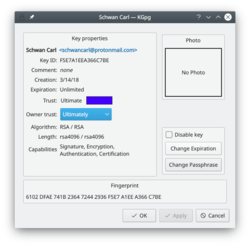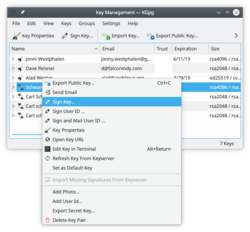KGpg/pt-br: Difference between revisions
MarcusGama (talk | contribs) No edit summary |
Updating to match new version of source page |
||
| Line 1: | Line 1: | ||
<languages /> | <languages /> | ||
__TOC__ | |||
{|style="text-align:center" | {|style="text-align:center" | ||
|[[Image:Kgpg-keymgr.png|250px]]|| ||''O 'KGpg fornece uma interface gráfica para os comandos do gpg''' | |[[Image:Kgpg-keymgr.png|250px]]|| ||''O 'KGpg fornece uma interface gráfica para os comandos do gpg''' | ||
| Line 11: | Line 13: | ||
|[[Image:Kgpg-props.png|thumb|250px|Ver as propriedades da chave]]|| ||[[Image:Kgpg-options.png|thumb|250px|Clique-direito na chave para ver as opções]] | |[[Image:Kgpg-props.png|thumb|250px|Ver as propriedades da chave]]|| ||[[Image:Kgpg-options.png|thumb|250px|Clique-direito na chave para ver as opções]] | ||
|} | |} | ||
== Extending the life of your keys == | |||
As you can see in the image above, you can extend the life of your keys using the <menuchoice>Change Expiration</menuchoice> button. Simply choose the new date from the popup calendar. To do this, however, you must have access to the private key and its pass-phrase. Without them you can do nothing. | |||
== Change your pass-phrase == | |||
Should you suspect your pass-phrase is compromised, you can change this also from the Key Properties dialogue. The <menuchoice>Change Passphrase</menuchoice> button is below <menuchoice>Change Expiration</menuchoice>. | |||
== Revoking a key == | |||
If you lose your private key or think it has been compromised in some way you need to revoke it. To reliably render a key unusable you need to revoke it. Revoking is done by adding a special revocation signature to the key. | |||
The revocation signature can be created together with the key. In this | |||
case it is stored in a separate file. This file can later be imported into | |||
the keyring and is then attached to the key rendering it unusable. {{Warning|1=Please | |||
note that to import this signature to the key no password is required. | |||
Therefore you should store this revokation signature in a safe place, | |||
usually one that is different from you key pair. It is a good advise to | |||
use a place that is detached from your computer, either copy it to an | |||
external storage device like an USB stick or print it out.}} | |||
If you have not created such a detached revocation on key creation you can | |||
create such a revocation signature at any time choosing <menuchoice>Your Key -> Revoke key</menuchoice>, optionally importing it to your keyring immediately. | |||
{{Note|1=Currently this item is only available in the context menu. This is likely to be moved from the context menu to the key menu for 4.7.1. }} | |||
::{{Tip|Quando você inicia o '''KGpg''' com as configurações padrão, ele ficará oculta na bandeja do sistema. Se você iniciar o '''KGpg''' e não vê-lo em nenhum lugar você provavelmente pode encontrá-lo ao expandir o widget da bandeja de sistema do [[Special:myLanguage/Plasma|Plasma]].}} | ::{{Tip|Quando você inicia o '''KGpg''' com as configurações padrão, ele ficará oculta na bandeja do sistema. Se você iniciar o '''KGpg''' e não vê-lo em nenhum lugar você provavelmente pode encontrá-lo ao expandir o widget da bandeja de sistema do [[Special:myLanguage/Plasma|Plasma]].}} | ||
Revision as of 15:07, 14 September 2011
 |
O 'KGpg fornece uma interface gráfica para os comandos do gpg' |
O GnuPG criptografa e decriptografa suas mensagens de correio e arquivos selecionados. Existem muitas opções de linha de comando para fazer isto. Com o KGpg a ansiedade é descartada - você não precisa mais decorar qualquer comando. O KGpg pode auxiliá-lo a configurar e gerenciar suas chaves, importar e exportar chaves, ver assinaturas, status de confiança e datas de expiração das chaves. De fato, praticamente tudo de que você precisa é fornecido pelo KGpg. Um assistente é disponibilizado para auxiliá-lo a configurar suas chaves.
O KGpg é integrado ao Konqueror e o Dolphin, onde um menu de contexto permite que você opte por criptografar um arquivo, com ou sem assinatura.
 |
 |
Extending the life of your keys
As you can see in the image above, you can extend the life of your keys using the button. Simply choose the new date from the popup calendar. To do this, however, you must have access to the private key and its pass-phrase. Without them you can do nothing.
Change your pass-phrase
Should you suspect your pass-phrase is compromised, you can change this also from the Key Properties dialogue. The button is below .
Revoking a key
If you lose your private key or think it has been compromised in some way you need to revoke it. To reliably render a key unusable you need to revoke it. Revoking is done by adding a special revocation signature to the key.
The revocation signature can be created together with the key. In this case it is stored in a separate file. This file can later be imported into
the keyring and is then attached to the key rendering it unusable.
If you have not created such a detached revocation on key creation you can
create such a revocation signature at any time choosing , optionally importing it to your keyring immediately.

Tip

Tip
Um manual totalmente ilustrado lhe ajudará em cada detalhe.
Se você não estiver condições de verificar fisicamente a identidade de seus contatos, você deve ler a seção de assinatura de chaves que explica os benefícios da assinatura local.


